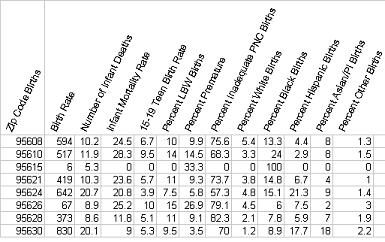| Title Analytical Framework of GIS in Improving Healthcare: Preventable Newborn Readmissions | ||
|
Author Cheryl Jean McQuirk American River College, Geography 350: Data Acquisition in GIS; Fall 2004 Contact Information ((916)961-2471) | ||
|
Abstract GIS is improving efficiency in healthcare organizations. Neonatal Care can be improved by GIS. | ||
|
Introduction Birth data geographically referenced by zip code can be used for analysis toward discharge planning for Neonatal Care. Improvement in discharge planning may be helpful in addressing preventable readmissions. Organized outpatient care within the community and preventing readmission with comprehensive discharge planning for newborns maximizes funds, materials, human resources,and more. How might Neonatal Care be improved by GIS? | ||
|
Background ESRI's website displays a broad range of healthcare applications. Well managed care can streamline cost while increasing efficiency. Health organizations are currently using GIS to: track infectious disease; find child immunization gaps; locate nearest healthcare facility and providers; manage patient environment and clinical resources; manage materials, supplies, employees; display clinical data in a visual and geographic form; organize community healthcare needs etc...(ESRI, 2004). The community context must be considered planning outpatient care and discharge. Being a nursing student hoping to work in neonatal care before going into management, I examined birth data. The Department of Health and Human Services displayed infant mortality rate, teen birth rate, percent premature birth, etc... in a geographic context that can be used for analysis in a GIS. | ||
| View GIS applications to
healthcare at
ESRI's website. (ESRI) The Department of Health and Human Services Division of Public Health for the County of Sacramento has free data available online at (Sacramento Department of Health and Human Services) |
 | |
|
Methods Reviewed ESRI's website of GIS in health and community services. A Google search of "downloadable Sacramento health data" led to the desired link. Neonatal data was found documented by zip code. I started with 2002 and put the data into Excel. Assessed potential for newborn risk after discharge based on the Sacramento birth data. Newborn risk during recovery should be part of discharge planning. I chose to use birth rate, infant mortality rate, teen birth rate, percent low birth weight, percent premature, percent hispanic births, percent black births,and percent inadequate prenatal care as an indication of potential problems leading to readmission. These potential cases should warrant an extra day at least before discharge. An extra day before discharge can have a significant impact on recovery in these cases, and may prevent readmission with even longer stays. | ||
|
Results I chose to use birth rate, infant mortality
rate, teen birth rate, percent low birth weight, percent premature,
percent hispanic births, percent black births,and percent inadequate
prenatal care as an indication of potential problems leading to readmission.
Identifying zip codes that need outpatient care organized within the
community can facilitate service
while being cost-effective in comparison with costly readmissions. | ||
|
Analysis The Department of Health and Human
Services has very useful birth data.
Comparing data for several consecutive years would help identify trends and concerns.
Welfare services might be able to maximize funds using newborn data in GIS.
This newborn data can also be used by Social Service caseworkers, nurses
administering out-patient care, hospital discharge planners, and much more. | ||
|
Conclusions Even Neonatal Care can benefit from geographic information systems. Healthcare is evolving with GIS analysis. | ||
|
References _GIS for Health and Human Services_ http://esri.com/health Accessed:2004.12.10 _Birth data by zip code_http://www.sacdhhs.com/CMS/download/pdfs/PUB/PUB_2002BirthDataByZip.PDF. Accessed:2004.12.10 | ||
|
| ||